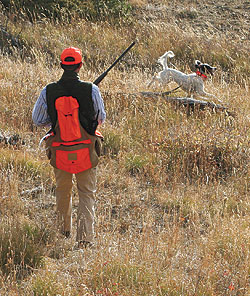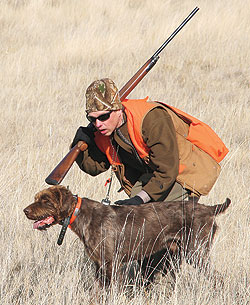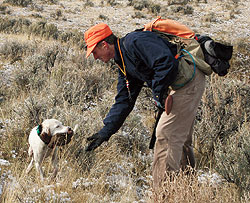You know all about bad luck. News flash: It happens to your dog, too.
By Dave Carty
 Determining whether your dog is just skylarking, having a bad day or deliberately ignoring training is often a hard call to make and requires you to take many variables into account. |
Typically, my dogs hit the wall about halfway through the season. But Hanna had been running on an even keel since September, long enough that it seemed we might actually make it through an entire year with no major screw-ups. And then, with the wind in her sails, she plowed full speed into an iceberg that, in my heart of hearts, I knew was there all along.
On the last day of the Arizona Mearns season, I was hunting a steep, vertiginous jumble of crumbling rock and oak trees that reminded me more of chukar hunting than the Mearns country I've come to love. Nonetheless, it was loaded with quail. And sure enough, not 200 yards from the truck, Hanna slammed into a point.
That, as it turned out, would be the apex of the trip.
I've spent countless hours teaching her and my other dogs the manners I like to see: steady to wing and shot, a prompt retrieve to hand, the whole picture-perfect nine yards.
But apparently something in her fuzzy canine mind snapped.
As I walked up behind her, she rolled her eyes back at me and then, an instant later, jumped into the middle of the covey. Birds blew up everywhere, and Hanna took off in frenzied pursuit.
For the next several minutes, I tracked her progress by the glimpses of white fur flashing through the oaks followed by the depressing whirr of yet another flushing quail. When she'd had her fill -- my whistles and screams notwithstanding -- she ran back, only to stumble through the middle of several birds that had somehow gone undetected through the entire previous fiasco. She chased those, too. What in God's name got into her that day I will never know.
I long ago accepted the utter, irrefutable reality that dogs, just like people, have bad days; that sometimes, stuff just€¦happens. Dogs make bad decisions and mistakes, no matter how well they've been trained. Aside from the hundreds of bust-the-bird-and-chase-it episodes I've endured, I've also seen dogs literally run through a covey of birds without scenting them, and I once sent my spaniel to retrieve a pheasant that, try as he might, he couldn't locate -- even though at one point he was actually standing on the dead bird.
Usually these are isolated instances, and often as not, the best thing to do is to simply ignore them. There's no solution for a problem you can't define.
But if a certain type of mistake continues for several days, or for some reason your dog has been backsliding for a week or two, then you need to evaluate the situation and make a decision: is it a training issue or is it just plain bad luck?
 Reinforcing "whoa" in the field -- especially after a transgression -- takes time but pays big dividends in the long run. |
In Hanna's case, it was clearly a training issue. Although she'd been thoroughly schooled, she'd decided that, for whatever reason, the rules no longer applied. She was mistaken. After I finally got her to come back in, I picked her up, marched her back downhill to where she'd busted the covey, and set her down, not gently, at the scene of the crime. I grabbed her collar, made her look at me, and in my best no-nonsense voice told her to "whoa!" And there I made her stand for the next five minutes. She got the message, and was good for the rest of the hunt.
But there's a whole host of other ways a dog can screw up unintentionally, for which they often, and erroneously, get the blame. A couple weeks earlier, I'd been hunting with a buddy -- same dog, different mountain -- when a pair of Mearns flushed out ahead of her, and Hanna, who was also running in that direction, briefly chased. My friend commented that she'd "run them up," not an accusation I take lightly.
But had she really? I had to stop and think about what I'd seen. The wind had been blowing from her to the birds, so she obviously hadn't scented them, nor had she been acting birdy, indicating to me, anyway, that she had no idea the quail were there. And yes, she did give chase€¦but I don't prevent my dogs from chasing birds if they haven't first pointed them.
So my friend was wrong. Hanna hadn't "run them up" on purpose; she'd bumped them accidentally, a situation she couldn't control. And the subsequent chase? My training issue, not hers. Clearly, the whole episode was simply bad luck, and no correction was called for.
Unfortunately, many cases aren't so cut and dried. Let's say you're working a dog across a half section of wheat. She runs upwind into a grassy border, slows down, then begins making, tight, close casts, her tail windmilling. She's found something, and judging from the cover, it's probably a covey of Huns. But although she knows the birds are in the general vicinity, she hasn't quite got a fix on them. And then, as so often happens with these super goosey birds, the covey goes up when she's still 75 yards downwind.
What happened? Did she run them up? Maybe, since she was obviously working the birds. Did she push them a little too hard? Could be, because an experienced dog will often point coveys from 50 to 100 yards back.
In this situation, which, incidentally, has happened to me hundreds of times, I'd do my best to look at the variables. In this case the dog was getting birdy, so obviously she knew a covey was nearby. Next questions: how old was the dog, and how much experience did she have? Inexperienced dogs often try to crowd wild birds, especially if, during yard work, they've been trained on planted pigeons and quail.
 Hanna, the author's setter, retrieves a Hun. Sometimes things work out the way they're supposed to, but when they don't, it's not always the dog's fault. |
How well trained was the dog? If it was a young or lightly trained animal, I'd chalk it up to experience and let it go, knowing the dog would eventually figure things out on its own. If it were an experienced Hun dog, however, a
s all my dogs are, and I was pretty sure she'd been careless in her handling of the covey, she'd probably earn a verbal rebuke, but that would be it. Why not a solid correction? Because Huns, like every other gamebird, sometimes behave in inexplicable ways.
That seems to go against the average bird hunter's conviction that every quirk in animal behavior has a logical reason, but it just ain't so. I've been told by countless friends that Huns, pheasants, grouse, whatever, do such and such under this situation, or do this and that under another, but my 40 years of bird hunting simply doesn't bear this out.
Certainly, within broad parameters, gamebirds will behave in predictable manners€¦but they may not, too. Which is my long-winded way of saying that it might not have been the dog's fault at all; it might simply have been bad luck. That said, though, you can bet I'd be watching her like a hawk the next time she got birdy.
If she continued to bump birds, however, I'd begin to suspect her training had gone awry.
In fact, this is quite common, since most hunters fail to maintain the high level of discipline in the field that they've been drilling into their dogs all summer in the yard.
What usually happens is this: the dog goes on point, the hunter walks up intent on shooting the bird, not monitoring his dog, and the dog, who always seems to know when you're not paying attention, busts the bird and chases it over the hill. Instead of stopping the dog and handling the situation immediately with a brief training session, the hunter curses out his wayward mutt and then continues to hunt. He hasn't got the time to deal with it right now.
That's a common, and quite understandable, reaction, particularly for those whose hunting time is measured in precious days, not weeks. But it's precisely the wrong thing to do. Dragging a dog back and making it whoa until released isn't as effective as an immediate correction, but it will serve as a reminder of what you expect. Then, back home, you can and should run the dog through whoa drills for several days (with planted birds if you have them) as a refresher course. Aim for perfection, but temper your aim with an understanding that dogs have no such ideals.
As I ease kicking and screaming into geezerhood, I'm no longer so sure of myself. I'm no longer convinced, as I was when I was younger, that every time my dog busts a bird, ignores a retrieve, or runs away that he's doing it solely to spite me. And with that growing outlook on things canine -- you might call it a glimmer of wisdom -- I've learned to cut the dog some slack when it's warranted. That's made it a lot easier for them. Funny thing is, it's made it easier for me, too.






